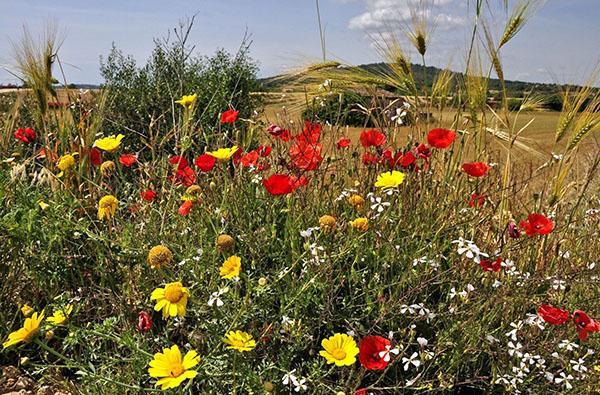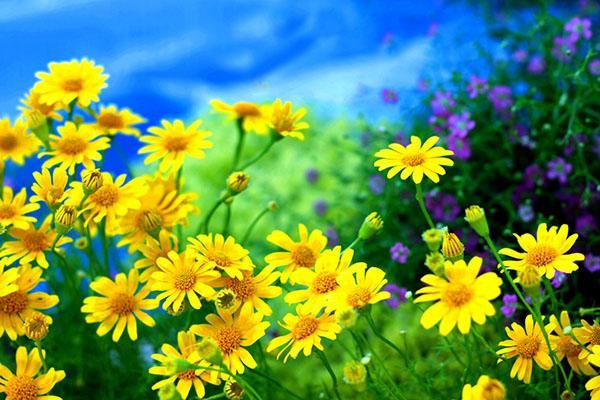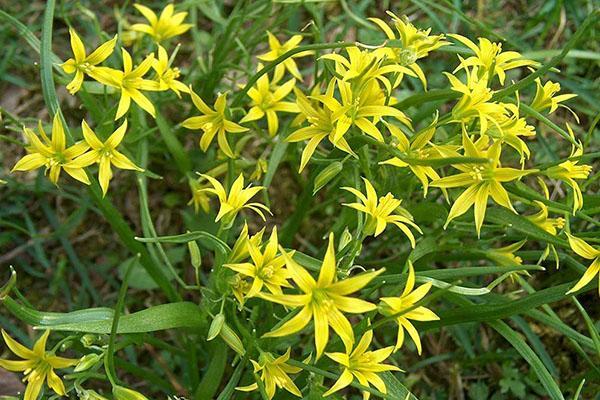Beauty and benefits of the Russian land - meadow and wildflowers
 In the floodplains of rivers and lakes, in spring and summer, you can find a wide variety of vegetation: these are meadow flowers and herbs that create a motley or delicate flavor of earthly clothing. There are perennial, biennial, annual flowers in fields and meadows, propagated by seeds (self-seeding), roots (vegetatively), pollination (with the help of birds and insects).
In the floodplains of rivers and lakes, in spring and summer, you can find a wide variety of vegetation: these are meadow flowers and herbs that create a motley or delicate flavor of earthly clothing. There are perennial, biennial, annual flowers in fields and meadows, propagated by seeds (self-seeding), roots (vegetatively), pollination (with the help of birds and insects).
Different geographic zones differ in their characteristics and names of growing herbs, which choose a more comfortable climate for maturation and reproduction. Plants and flowers of fields and meadows can be creeping, undersized (up to 15 cm), medium and high light-loving (up to 2 m). Meadow and field plants are bright, delicate, two-colored, variegated, dark. Colors prevail among them: yellow, blue, purple, white, pink, red.
Yellow grass natural landscapes

Goose bow
 A low-growing plant no higher than 15 cm has long leaves growing at the roots, small bright yellow flowers, expressively smelling of honey. It is used as a cosmetic and medicine.
A low-growing plant no higher than 15 cm has long leaves growing at the roots, small bright yellow flowers, expressively smelling of honey. It is used as a cosmetic and medicine.
Elecampane
 Grows in bushes up to 1 m high. Leaves are narrow, light green, inflorescences are orange or yellow. Flowers are single or in bunches. It is used for face and body care, as well as in traditional medicine.
Grows in bushes up to 1 m high. Leaves are narrow, light green, inflorescences are orange or yellow. Flowers are single or in bunches. It is used for face and body care, as well as in traditional medicine.
Donnik
 Melilot also belongs to the yellow wildflowers. This is one of the tallest flowers that grow taller than human growth (up to 2 m). The stems are evenly covered with three-toed leaves. Small flowers (yellow or white) arranged in brushes.
Melilot also belongs to the yellow wildflowers. This is one of the tallest flowers that grow taller than human growth (up to 2 m). The stems are evenly covered with three-toed leaves. Small flowers (yellow or white) arranged in brushes.
Sweet clover heals wounds, relieves inflammation and cramps, heals a wet cough.
Delphinium
 This shrub plant is even higher - up to 1.5 m. The area at the roots is supplied with narrow lancet leaves. The flowers are small, they come in different colors, including yellow, and are pyramidal on a long stem. Delphinium is added as a useful ingredient in the production of soap.
This shrub plant is even higher - up to 1.5 m. The area at the roots is supplied with narrow lancet leaves. The flowers are small, they come in different colors, including yellow, and are pyramidal on a long stem. Delphinium is added as a useful ingredient in the production of soap.
Field plants with yellow buds can continue the above list. These include: zopnik (or feverish root), St. John's wort, tansy, spring adonis, buttercup, thistle, goldenrod, rapeseed, mullein, goldenseed, celandine, swimsuit and many others.
Blue wildflowers

The main ones among the blue flowers of meadows and fields can be distinguished: chicory, common aquilegia, gentian, delphinium, field larkspur, lupine, cornflower, peach-leaved bell, multicolored pansies with a predominance of blue-violet color, common bruise. Here are photos of blue wildflowers with names.
Chicory
 It has a powerful, fleshy root filled with milky juice. The stem with multiple branches grows up to 120 cm in height. Leaves grow from the middle of the stems, collected in rosettes. The flowers of this meadow plant are blue-blue (there are white and pink species), with serrated petals, bordered by leaves, located along the length of the stems and at their tops. Loves the sun, flowers close in the afternoon.
It has a powerful, fleshy root filled with milky juice. The stem with multiple branches grows up to 120 cm in height. Leaves grow from the middle of the stems, collected in rosettes. The flowers of this meadow plant are blue-blue (there are white and pink species), with serrated petals, bordered by leaves, located along the length of the stems and at their tops. Loves the sun, flowers close in the afternoon.
Chicory is useful for the nervous system, heart and blood vessels, kidneys and liver.It is a healthy animal feed.
Aquilegia ordinary
 Shrub meadow flowers of medium height (up to 80 cm). They are not afraid of frost. Large inflorescences on high thin legs can be of very different colors: blue, white, red, pink, purple, black, lilac. Aquilegia treat pneumonia, sore throat, skin diseases, wounds and burns, scurvy, headaches and stomach pains.
Shrub meadow flowers of medium height (up to 80 cm). They are not afraid of frost. Large inflorescences on high thin legs can be of very different colors: blue, white, red, pink, purple, black, lilac. Aquilegia treat pneumonia, sore throat, skin diseases, wounds and burns, scurvy, headaches and stomach pains.
Gentian
 It is a semi-shrub with a permanent lower part in the form of bushy branches and a replaceable grassy top. Reaches a height of 1.5 m. It has memorable flowers in the form of large bells of blue, purple and pale blue color. Gentian root is used for indigestion, gout, eye diseases, anemia, diathesis, heart failure.
It is a semi-shrub with a permanent lower part in the form of bushy branches and a replaceable grassy top. Reaches a height of 1.5 m. It has memorable flowers in the form of large bells of blue, purple and pale blue color. Gentian root is used for indigestion, gout, eye diseases, anemia, diathesis, heart failure.
Cornflower blue
 Reaches 1 m in height, the leaves are elongated, faded green. The flowers grow in a beautiful blue basket. It is used to treat the kidneys, urinary tract, cardiovascular system, eye and women's diseases, joints, stomach.
Reaches 1 m in height, the leaves are elongated, faded green. The flowers grow in a beautiful blue basket. It is used to treat the kidneys, urinary tract, cardiovascular system, eye and women's diseases, joints, stomach.
Purple meadow plants
Dzhungarian Aconite, comfrey, peach-leaved bell, gentian, mouse peas, lumbago, pansies - purple wildflowers, the names and photos of some of them are shown in this section.
Dzhungarian Aconite
 It grows in the form of a bush, loves a lot of sun, therefore it reaches a height of up to 2 m. Leaves are soft, rounded, cut into 5 parts. Inflorescences are large, five-petal, dark purple. It is used for anemia, infertility, diabetes mellitus, angina pectoris, ulcers, bronchitis, arthritis, psoriasis, head lice, cancer, poisoning with poisonous mushrooms.
It grows in the form of a bush, loves a lot of sun, therefore it reaches a height of up to 2 m. Leaves are soft, rounded, cut into 5 parts. Inflorescences are large, five-petal, dark purple. It is used for anemia, infertility, diabetes mellitus, angina pectoris, ulcers, bronchitis, arthritis, psoriasis, head lice, cancer, poisoning with poisonous mushrooms.
Comfrey medicinal
 These meadow flowers are a tough, rough plant, the maximum height is up to 90 cm. The stem is branched, the leaves are oblong, larger at the base. The flowers are purple with a purple tinge, they look like a tubular bell. The beneficial properties of comfrey root are used to relieve inflammation, stop bleeding of various origins, treat tumors and ulcers, relieve fractures and dislocations, and confidently eliminate the purulent process.
These meadow flowers are a tough, rough plant, the maximum height is up to 90 cm. The stem is branched, the leaves are oblong, larger at the base. The flowers are purple with a purple tinge, they look like a tubular bell. The beneficial properties of comfrey root are used to relieve inflammation, stop bleeding of various origins, treat tumors and ulcers, relieve fractures and dislocations, and confidently eliminate the purulent process.
White, red, pink, white-pink, lilac flowers of fields and meadows
 Many colors of various scales and shades can be seen during flowering in meadows and fields. It is pleasing to the eye when meeting nature with the wildflowers of Russia (see below photo of flowers and names): marshmallow officinalis, spike amaranth, wild rosemary, valerian officinalis, forest anemone, meadow carnation, serpentine mountaineer, cuckoo adonis, wintergreen, wild onion, narrow-leaved fireweed (ivan tea), clover, hazel grouse Russian, cumin.
Many colors of various scales and shades can be seen during flowering in meadows and fields. It is pleasing to the eye when meeting nature with the wildflowers of Russia (see below photo of flowers and names): marshmallow officinalis, spike amaranth, wild rosemary, valerian officinalis, forest anemone, meadow carnation, serpentine mountaineer, cuckoo adonis, wintergreen, wild onion, narrow-leaved fireweed (ivan tea), clover, hazel grouse Russian, cumin.
Althea officinalis
 A short flower up to 50 cm in height with oblong greenish leaves located along the entire height of the stem: at the bottom - larger, higher - gradually smaller. Pale pink flowers grow one at a time, they can reach 10 cm in diameter. Altey is not adapted to severe frosts, it feels comfortable in central Russia. The root of the flower is used in the treatment of coughs and stomach ulcers, and to enhance immunity.
A short flower up to 50 cm in height with oblong greenish leaves located along the entire height of the stem: at the bottom - larger, higher - gradually smaller. Pale pink flowers grow one at a time, they can reach 10 cm in diameter. Altey is not adapted to severe frosts, it feels comfortable in central Russia. The root of the flower is used in the treatment of coughs and stomach ulcers, and to enhance immunity.
Valerian officinalis
 Stretches up to 1.5 m in height. The leaves are attached to the stem with a long petiole. Light pink fragrant inflorescences look like umbrellas. In medicine, a drug based on valerian root is used as a sedative for headaches, pressure, angina pectoris, thyroid diseases, cholelithiasis, problems in the urinary tract, during menopause in women.
Stretches up to 1.5 m in height. The leaves are attached to the stem with a long petiole. Light pink fragrant inflorescences look like umbrellas. In medicine, a drug based on valerian root is used as a sedative for headaches, pressure, angina pectoris, thyroid diseases, cholelithiasis, problems in the urinary tract, during menopause in women.
Narrow-leaved fireweed

Forest anemone

Wild bow

Explanation of some names
Meadow flowers, in addition to the official Latin name, have a name that was given by people. For example, coltsfoot got its name from the contrast between the upper (warm, fleecy) and lower (cold, smooth) parts of the leaf.
Elecampane relieves fatigue, gives "nine forces."Cornflower is a symbol of purity and holiness, named after Saint Basil, who loved flowers with great love. Ivan da Marya is named according to the legend about unhappy love, which was not destined to come true.
According to the Russian legend, multicolored pansies are the color of hope, surprise and sadness of a girl whose heart could not stand the vain expectation of her beloved. The carnation was named for its resemblance to an ancient forging nail. The roots and leaves of gentian are so bitter that this taste is the name of the flower.
Photos with the names of wildflowers are shown below.
Ivan da Marya

Pansies

Meadow carnation

Flowers-honey plants
In the height of summer, when the honey flowers in the field secrete nectar for cross-pollination, the bee workers collect this healing sweet liquid for further honey production.
The most melliferous plants are:
- mint;

- pine cone;

- ammi dental;

- motherwort;

- coriander.

Flowers-melliferous plants also include: anise, peppermint, spicate lavender, caraway seeds, meadow cornflower, autumn culbaba, lungwort, dandelion, mother and stepmother. Depending on the name of the flower, honey productivity per hectare ranges from 30 to 1300 kg. Below are photos and names of some wildflowers-melliferous plants.
Nature has generously endowed a person with an untold wealth of flora, which heals from ailments, delights with its special beauty, purifies the soul and improves mood.
one niggle ... ..a picture with sage and the name of the norichnik ... norichnik is another plant from the sem.
Thank you for your attention. The author's mistake was corrected.
in the section Delphinium snapdragon photo)) delphinium other
Replaced.
And what is the name of the pink plant on a thin long stem from the video, almost at the end?